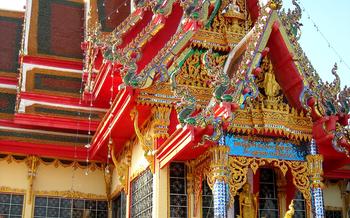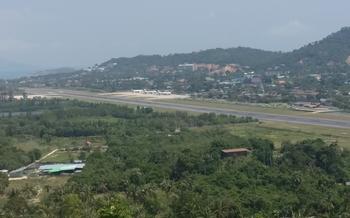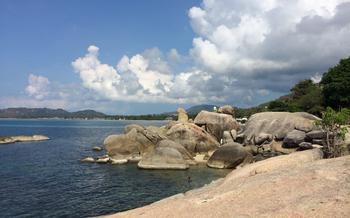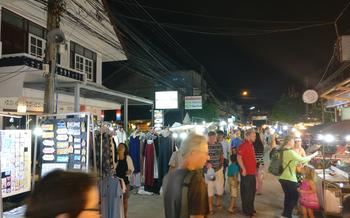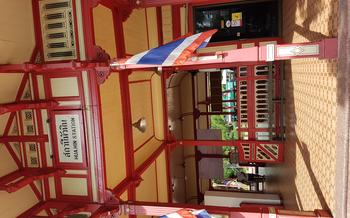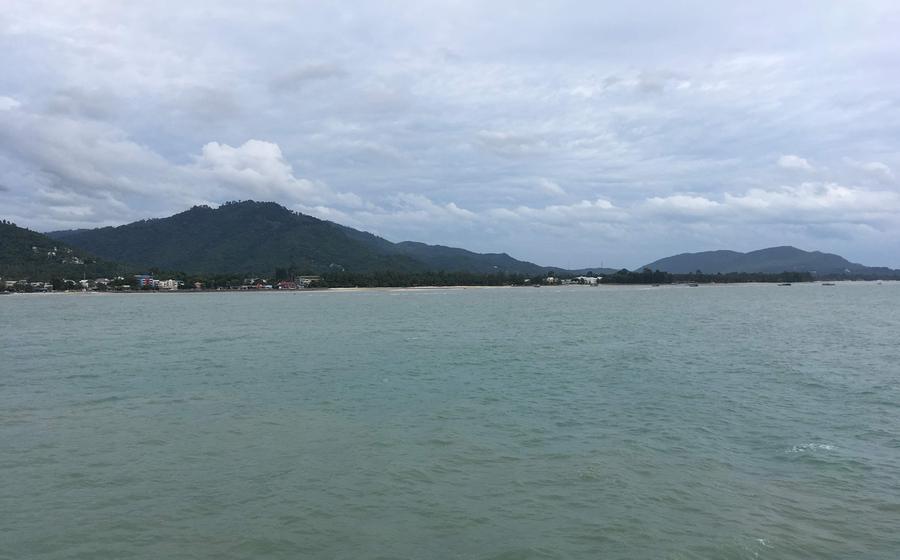
Wat Sila Ngu (Red Temple)
- Exploring the Temple Grounds
- The "Red Temple" Distinction
- The Grand Buddha Statue: A Symbol of Peace and Serenity
- The Temple's Spiritual Significance
- Surrounding Landscape and Views
- Visiting During Festivals
- Local Markets and Street Food
- Gastronomic Delights
- Engaging with Locals
- Meditation and Mindfulness
- Cultural Performances and Shows
- Local Customs and Traditions:
- Nearby Attractions and Activities:
- Photography Tips and Techniques
Exploring the Temple Grounds
The Wat Sila Ngu complex is a maze of interconnected buildings, courtyards, and gardens, each with its unique charm and significance. As you wander through the temple grounds, you'll encounter a variety of notable structures, including the main prayer hall, the ordination hall, the bell tower, and several smaller shrines dedicated to various deities.
The main prayer hall is the heart of the temple, where monks and devotees gather for daily prayers and ceremonies. The interior of the hall is adorned with intricate murals depicting scenes from the life of Buddha and Thai mythology. The ordination hall is where young men are ordained as monks, and it features a large Buddha statue and rows of seating for the participants.
The bell tower, with its distinctive shape and towering height, is a prominent landmark within the temple complex. Visitors are allowed to climb up the tower for panoramic views of the surrounding area. Among the smaller shrines, the most notable are the shrine dedicated to the goddess of mercy, Guanyin, and the shrine dedicated to the Chinese monk, Jigong. These shrines are popular among both local and foreign devotees.
As you explore the temple grounds, pay attention to the various statues and sculptures that adorn the buildings and courtyards. These statues depict a variety of figures, including Buddha in various poses, mythical creatures, and historical figures. Each statue has its own unique meaning and symbolism, adding to the overall spiritual and cultural significance of the temple.
The "Red Temple" Distinction
The Wat Sila Ngu is commonly referred to as the "Red Temple" due to its striking red color, which sets it apart from other temples on Ko Samui. The vibrant hue is derived from the red laterite stones used in its construction, giving the temple its distinctive appearance. The temple's name, Sila Ngu, translates to "nine precious stones," which symbolizes the nine types of gems believed to bring good fortune and prosperity.
The use of red laterite stones is unique to the Wat Sila Ngu, as most temples in Thailand are constructed from gray sandstone or white marble. This unique architectural feature has made the temple a popular tourist attraction, drawing visitors from around the world who are captivated by its vibrant color and intricate details.
The temple's fame has had a positive impact on the local community, as it has increased tourism and brought recognition to the area. The influx of visitors has also contributed to the development of local businesses, such as souvenir shops, restaurants, and tour companies, which have benefited from the increased foot traffic.
The Grand Buddha Statue: A Symbol of Peace and Serenity
Amidst the serene grounds of Wat Sila Ngu, the majestic Grand Buddha statue stands tall, radiating an aura of peace and tranquility. Crafted from solid granite, this impressive statue stands at an astounding height of 12 meters, making it one of the largest Buddha images on Ko Samui. The intricate details and serene expression of the Buddha exude a sense of divinity and spirituality, captivating the hearts of visitors.
The statue's spiritual significance extends beyond its physical presence. It is believed to embody the essence of Buddhahood, representing the path to enlightenment and liberation from suffering. Devotees and visitors alike offer prayers and make offerings to the Buddha, seeking blessings, guidance, and inner peace.
The Grand Buddha statue has become a symbol of Ko Samui, representing the island's rich cultural heritage and deep-rooted Buddhist traditions. It is a popular destination for both local residents and tourists, who come to pay homage, meditate, or simply soak in the peaceful atmosphere that surrounds it.
In my personal experience, standing before the Grand Buddha statue was a truly awe-inspiring moment. The sheer size and intricate details of the statue were breathtaking, and I felt a profound sense of serenity and tranquility wash over me. It was a reminder of the power of faith and the importance of seeking inner peace amidst the chaos of the world.
The Temple's Spiritual Significance
Wat Sila Ngu holds immense spiritual significance for the local community, serving as a sacred space for religious practices and spiritual growth. Throughout the year, the temple hosts various ceremonies, rituals, and festivals that showcase the vibrant Buddhist traditions of Thailand. Devotees flock to the temple to participate in these events, seeking blessings, making offerings, and connecting with their faith.
One of the most important ceremonies held at the temple is the daily morning alms-giving ritual. During this ritual, monks gather at the temple grounds to receive food offerings from the local community. This act of merit-making is believed to bring good fortune and blessings to those who participate. Visitors are welcome to observe this ceremony and experience the devotion and generosity of the local people.
The temple is also known for its annual temple fair, which takes place during the Songkran festival in April. During this time, the temple grounds come alive with colorful decorations, music, and traditional Thai performances. Locals and visitors alike gather to celebrate the Thai New Year, engage in merit-making activities, and enjoy the festive atmosphere.
Participating in or observing these religious activities at Wat Sila Ngu offers visitors a glimpse into the rich spiritual traditions of Thailand and the deep connection between the local community and their faith. The temple fosters a sense of community and cultural identity, bringing people together to share in their beliefs and practices.
Surrounding Landscape and Views
The Wat Sila Ngu is blessed with a breathtaking location amidst lush greenery and natural beauty. The temple grounds are surrounded by towering trees, exotic plants, and colorful flowers, creating a tranquil and serene atmosphere. Visitors can enjoy panoramic views of the island and the surrounding seas from various vantage points within the temple complex. The temple's elevated position offers unobstructed vistas of the Gulf of Thailand, with neighboring islands and the mainland visible in the distance. The natural surroundings contribute to the temple's peaceful and meditative ambiance, making it an ideal place for self-reflection and spiritual contemplation. Capturing stunning photographs of the temple and its surroundings is a must-do for visitors, especially during sunrise or sunset when the golden light casts a magical glow on the landscape.
Visiting During Festivals
Wat Sila Ngu comes alive during festivals, showcasing the vibrant Thai culture and religious traditions. The temple's most prominent festival is the annual "Bun Phra That" (Buddha Image Festival), held during the full moon in February. During this time, the temple is adorned with colorful decorations, and locals gather for merit-making ceremonies, processions, and traditional performances.
Visitors can witness the parade of elaborately decorated floats carrying Buddha images around the temple grounds. The atmosphere is electric, with the sound of drums, cymbals, and chanting filling the air. Local vendors set up stalls selling delicious Thai food, snacks, and souvenirs, adding to the festive ambiance.
To experience the temple at its most vibrant, plan your visit to coincide with one of the festivals. It's an opportunity to immerse yourself in the local culture, witness the deep devotion of the Thai people, and create lasting memories of your time in Ko Samui.
Local Markets and Street Food
In the vicinity of Wat Sila Ngu, a vibrant local market and street food scene thrives, offering visitors a tantalizing taste of authentic Thai cuisine and culture. As you approach the temple, your senses will be awakened by the mouthwatering aromas wafting through the air. Stalls laden with an array of colorful tropical fruits, fragrant herbs, and freshly caught seafood line the streets. Indulge in the sweet succulence of ripe mangoes, savor the spicy kick of fiery chili peppers, or quench your thirst with a refreshing coconut drink.
Gastronomic Delights
For a true culinary adventure, sample the delectable street food offerings that are sure to tantalize your taste buds. From the ever-popular Pad Thai, with its harmonious blend of noodles, vegetables, and tangy sauce, to the irresistible Som Tum, a spicy papaya salad that packs a punch, there's something to satisfy every palate. Don't miss the chance to try the local specialty, Khanom Jeen, a delicate rice noodle dish served with a variety of flavorful curries.
Engaging with Locals
More than just a place to satisfy your hunger, the local markets provide an opportunity to interact with friendly vendors and immerse yourself in the local way of life. Engage in lively conversations, learn about the ingredients and cooking techniques, and discover hidden culinary gems that you might not find elsewhere. Whether you're a seasoned foodie or simply curious to explore new flavors, the markets near Wat Sila Ngu offer an unforgettable gastronomic experience.
Meditation and Mindfulness
The Wat Sila Ngu is an ideal destination for those seeking spiritual growth and inner peace. The temple's serene and tranquil environment provides the perfect backdrop for meditation and mindfulness practices. Visitors are welcome to find a quiet spot within the temple grounds, whether it be under the shade of a tree or in a secluded corner, and immerse themselves in meditation. The temple's atmosphere, coupled with the gentle sound of chanting monks, creates a conducive environment for self-reflection and spiritual exploration.
For those new to meditation, the temple's tranquil surroundings can be an excellent place to begin their practice. The peaceful atmosphere can help beginners to relax and focus their minds more easily. Experienced meditators may also find the temple to be a serene and inspiring place to deepen their practice and connect with their inner selves.
Meditation at the Wat Sila Ngu offers visitors a unique opportunity to combine cultural exploration with spiritual growth. By embracing the temple's peaceful ambiance and engaging in meditation, visitors can gain a deeper understanding of Thai culture and spirituality while simultaneously fostering their own inner peace and well-being.
Cultural Performances and Shows
The Wat Sila Ngu occasionally hosts cultural performances and shows that showcase the rich heritage of Thailand. These events typically feature traditional Thai dance, music, and martial arts demonstrations, providing visitors with a glimpse into the country's vibrant culture.
The performances are usually held in the temple's main courtyard or in a designated performance space. Visitors can sit on mats or cushions and enjoy the shows, which often include colorful costumes, rhythmic music, and graceful movements.
Attending a cultural performance at the Wat Sila Ngu is a wonderful way to learn more about Thai culture and traditions. It's also a great opportunity to appreciate the skill and artistry of the performers, who are often local artists or students from nearby schools.
To find out about upcoming performances, visitors can check the temple's website or inquire at the temple office. Tickets are usually sold at the door, and prices are typically very affordable.
Here's a personal anecdote: During my last visit to the temple, I had the opportunity to watch a traditional Thai dance performance. The dancers were adorned in elaborate costumes, and their movements were fluid and graceful. The music was enchanting, and the overall performance was mesmerizing. It was a truly unforgettable experience that gave me a deeper appreciation for Thai culture.
Local Customs and Traditions:
When visiting the Wat Sila Ngu, it is important to be mindful of local customs and traditions related to temple visits. One significant practice is the making of offerings to the Buddha images and monks. Visitors can purchase flower garlands, incense sticks, and candles from the temple vendors and present them as a gesture of respect and devotion. These offerings are believed to bring good luck and merit to the giver.
Another important custom is to maintain a respectful demeanor within the temple grounds. This includes removing shoes before entering the temple buildings, covering shoulders and knees with appropriate clothing, and speaking in a quiet and subdued manner. It is also considered polite to bow or wai (a traditional Thai greeting) to the monks and other visitors as a sign of respect.
By observing these local customs and traditions, visitors can show their appreciation for the temple's sacredness and contribute to the preservation of Thailand's rich cultural heritage.
Nearby Attractions and Activities:
The Wat Sila Ngu is conveniently located near several other popular attractions and activities on Ko Samui. Visitors can easily combine a visit to the temple with a day of sightseeing or adventure. Just a short drive away lies the stunning Lamai Beach, known for its crystal-clear waters, soft white sand, and vibrant nightlife. For those seeking breathtaking panoramic views, the nearby viewpoints of Lad Koh Viewpoint and Khao Pom Viewpoint offer unparalleled vistas of the island and the surrounding seas.
Nature enthusiasts will delight in exploring the lush greenery and diverse wildlife of the nearby Ang Thong National Marine Park. This archipelago of 42 islands boasts stunning coves, hidden lagoons, and pristine coral reefs teeming with marine life. Visitors can embark on snorkeling or diving excursions to discover the underwater wonders of the park.
For a unique cultural experience, head to the nearby Fisherman's Village, a charming neighborhood known for its traditional wooden houses, quaint shops, and delicious seafood restaurants. Visitors can stroll along the waterfront, browse local handicrafts, and savor the freshest catches of the day.
By combining a visit to the Wat Sila Ngu with these nearby attractions, visitors can create a well-rounded itinerary that offers a diverse range of experiences, from spiritual exploration to natural wonders and cultural immersion.
Photography Tips and Techniques
Capturing the beauty of Wat Sila Ngu through photography is a rewarding experience. Here are some tips to help you make the most of your visit:
-
Golden Hour Magic: The best time to photograph the temple is during the golden hours, just after sunrise or before sunset. The warm, diffused light casts a magical glow on the temple's red exterior, creating stunning photo opportunities.
-
Embrace the Details: Take your time to explore the intricate details of the temple's architecture. Zoom in on the delicate carvings, ornate pillars, and intricate murals to capture the essence of this sacred space.
-
Play with Perspectives: Experiment with different angles and perspectives to create dynamic compositions. Try shooting from a low angle to emphasize the grandeur of the temple or from a high vantage point to capture the sweeping views of the surrounding landscape.
-
Capture the Essence: When photographing a temple, remember to capture not just its physical beauty but also its spiritual essence. Look for moments of devotion, prayer, or meditation to convey the sacredness of the place.
